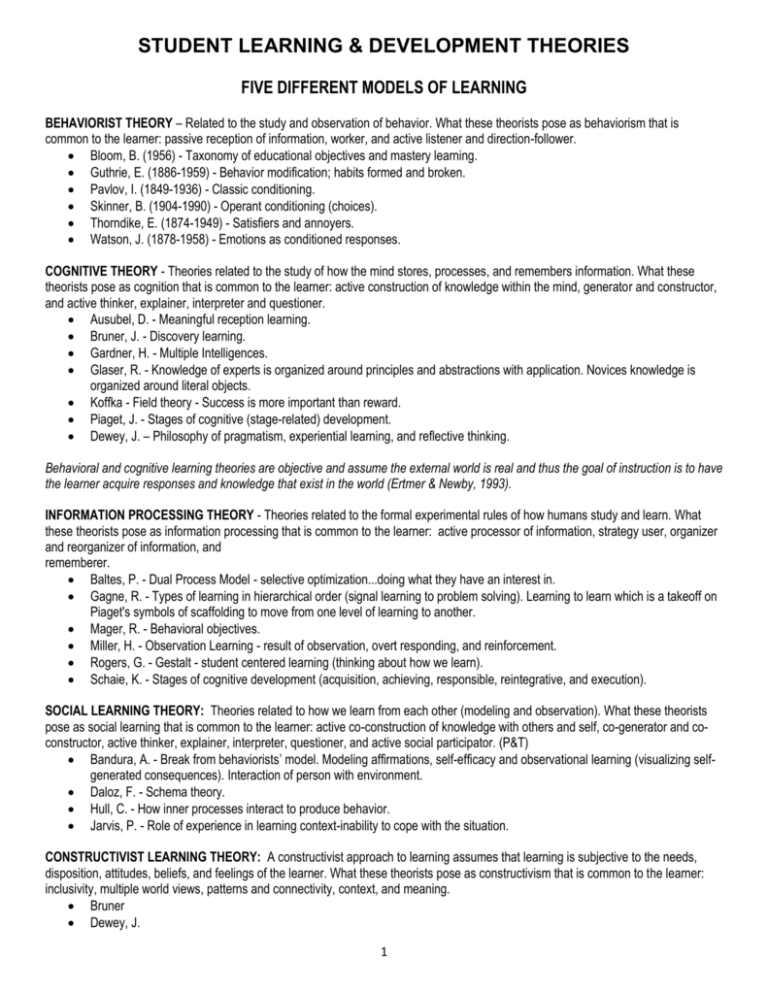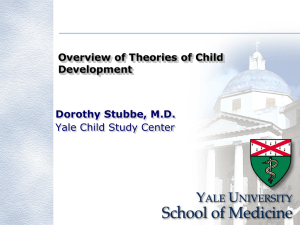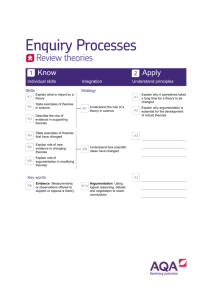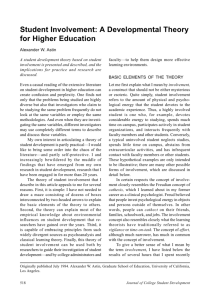Student Learning and Development Theories
advertisement

STUDENT LEARNING & DEVELOPMENT THEORIES FIVE DIFFERENT MODELS OF LEARNING BEHAVIORIST THEORY – Related to the study and observation of behavior. What these theorists pose as behaviorism that is common to the learner: passive reception of information, worker, and active listener and direction-follower. Bloom, B. (1956) - Taxonomy of educational objectives and mastery learning. Guthrie, E. (1886-1959) - Behavior modification; habits formed and broken. Pavlov, I. (1849-1936) - Classic conditioning. Skinner, B. (1904-1990) - Operant conditioning (choices). Thorndike, E. (1874-1949) - Satisfiers and annoyers. Watson, J. (1878-1958) - Emotions as conditioned responses. COGNITIVE THEORY - Theories related to the study of how the mind stores, processes, and remembers information. What these theorists pose as cognition that is common to the learner: active construction of knowledge within the mind, generator and constructor, and active thinker, explainer, interpreter and questioner. Ausubel, D. - Meaningful reception learning. Bruner, J. - Discovery learning. Gardner, H. - Multiple Intelligences. Glaser, R. - Knowledge of experts is organized around principles and abstractions with application. Novices knowledge is organized around literal objects. Koffka - Field theory - Success is more important than reward. Piaget, J. - Stages of cognitive (stage-related) development. Dewey, J. – Philosophy of pragmatism, experiential learning, and reflective thinking. Behavioral and cognitive learning theories are objective and assume the external world is real and thus the goal of instruction is to have the learner acquire responses and knowledge that exist in the world (Ertmer & Newby, 1993). INFORMATION PROCESSING THEORY - Theories related to the formal experimental rules of how humans study and learn. What these theorists pose as information processing that is common to the learner: active processor of information, strategy user, organizer and reorganizer of information, and rememberer. Baltes, P. - Dual Process Model - selective optimization...doing what they have an interest in. Gagne, R. - Types of learning in hierarchical order (signal learning to problem solving). Learning to learn which is a takeoff on Piaget's symbols of scaffolding to move from one level of learning to another. Mager, R. - Behavioral objectives. Miller, H. - Observation Learning - result of observation, overt responding, and reinforcement. Rogers, G. - Gestalt - student centered learning (thinking about how we learn). Schaie, K. - Stages of cognitive development (acquisition, achieving, responsible, reintegrative, and execution). SOCIAL LEARNING THEORY: Theories related to how we learn from each other (modeling and observation). What these theorists pose as social learning that is common to the learner: active co-construction of knowledge with others and self, co-generator and coconstructor, active thinker, explainer, interpreter, questioner, and active social participator. (P&T) Bandura, A. - Break from behaviorists’ model. Modeling affirmations, self-efficacy and observational learning (visualizing selfgenerated consequences). Interaction of person with environment. Daloz, F. - Schema theory. Hull, C. - How inner processes interact to produce behavior. Jarvis, P. - Role of experience in learning context-inability to cope with the situation. CONSTRUCTIVIST LEARNING THEORY: A constructivist approach to learning assumes that learning is subjective to the needs, disposition, attitudes, beliefs, and feelings of the learner. What these theorists pose as constructivism that is common to the learner: inclusivity, multiple world views, patterns and connectivity, context, and meaning. Bruner Dewey, J. 1 STUDENT LEARNING & DEVELOPMENT THEORIES Garai, L. Kolb, D. – Experiential Learning; Learning Style Inventory Technical Manual Montessori, M. – The Montessori Approach Piaget, J. Rorty Vico Vygotsky – Social Development Theory; Zone of Proximal Development; founder of cultural-historical psychology STUDENT DEVELOPMENT THEORIES 1. Psychosocial Theories / Student Development Process Models (Developmental): Address development issues or tasks and events that occur throughout the life span. These tasks and events tend to occur in sequence and are correlated with chronological age. Individuals process from one stage to another by accomplishing related developmental tasks or by resolving crisis. This is the “what” or “content” of student development. The focus is on long-term issues that tend to occur in sequence and are correlated with chronological age. These are developmental models that focus primarily on intraindividual change or growth. Cass, V. (1979, 1983-84) – Psychosocial Model of Sexual Identity Formation Chickering, A. (1969) – Seven Vectors Model Chickering, A. (1993)- Theory of Identity Development Cross, W. (1971, 1980, 1991, 1995) – Model of Nigrescence D’Augelli, A. (1994) – Model of Lesbian, Gay, and Bisexual Development Erikson, E. (1968) – Eight Stages of Life Long Identity Development Helms, J. (1971) – People of Color Racial Identity Model Helms, J. (1993) – White Identity Model Josselson, R. (1973, 1987, 1996) – Theory of Identity Development among Women Only Marcia, J. (1966, 1980) – Model of Identity Status Phinney, J. (1990, 1992) – Model of Ethnic Identity Development 2. Cognitive-Structural Theories (Developmental): Address how students reason, think, and make meaning of their experiences. Development is seen as hierarchical stages with each successive stage incorporating parts of the previous stage. This is the “how” or “process” of student development. Daloz Parks, S. (2000) – Development of an Understanding of Faith Fowler, J. (1981, 1991, 1996) – Spiritual Development Model Gilligan, C. (1977, 1979, 1981, 1982, 1986) – Model of Women’s Moral Development Kegan, R. (1982, 1994) – “Constructive-Developmental” Framework for Ego Development King & Kitchener (1994) – Reflective Judgment Model – Describes the development of reasoning from adolescence to adulthood. (ASHE, p. 424; 436-442) Kohlberg, L. (1958) - Theory of Moral Development Magolda, B. (1992) – Epistemological Reflection Model Perry, W. (1970) – Scheme of Intellectual and Ethical Development (ASHE, p. 424) 3. Person-Environment Theories / Typological Models (Developmental): Address interaction between conceptualizations of the college student and the college environment, looking at behavior as a social function of the person and the environment. Do not explain how one changes or what one believes. They look more at individual differences and the characteristics that are distinctive to each person, with the idea that these differences have an influence on development. Briggs, K. & Myers, I. – Myers-Briggs (Personality) Type Indicator Gardner (1983, 1987, 1993) – Multiple Intelligences Holland, J. – Theory of Vocational Personalities and Environments Holland, J. (1997) – Person-Environment Fit Theory Kolb, D. – Theory of Learning Styles and Experiential Learning Strange & Banning (2001) – Four Categories of Person-Environment Models Witkin (1962, 1976) – Cognitive Styles 2 STUDENT LEARNING & DEVELOPMENT THEORIES 4. Humanistic Theories: Concentrate on certain philosophical concepts about human nature: freedom, responsibility, selfactualization and that education and personal growth are encouraged by self-disclosure, self-acceptance, and self-awareness. They share a common philosophy of the human condition. Development is internally motivated. These theorists believe the forces of growth are within the person and are facilitated by self-disclosure, followed by self-acceptance and self-awareness. These theories are used extensively in counseling. 5. College Impact Models: They focus primarily on interindividual origins of student change and the extent to which such changes are related to attributes of the institutions that students attend and the experiences that they have. (P&T) Astin, A. (1970, 1991, 1993)– I-E-O Model Astin, A. (1970)– Theory of Involvement Tinto, V. (1975, 1987, 1993) – Theory of Student Departure Pascarella, E. (1985) – General Model for Assessing Change Pascarella, E. (1985) – Model of Learning and Cognitive Development Watson, L. (1996) – Conceptual Framework for Student Learning, Involvement, and Gains Weidman (1989) – Model of Undergraduate Socialization 6. Sociological Perspectives: Scholars identify problems in the adoption of developmental models for understanding the change process. Bourdieu & Passeron (1990) Bourdieu (1977, 1986) Dannefer (1984) Feldman & Newcomb (1969) Feldman (1972) Heath (1968) Kamens (1971, 1974) Kaufman & Feldman (2004) Meyer (1977) Smart, Feldman, & Ethington (2000) THREE IMPLICIT PEDAGOGICAL THEORIES 1. Subject-Matter Theory – Also called content theory. Student learning and development depend primarily on exposure to the right subject matter. 2. Resource Theory - Maintains that if adequate resources are brought together in one place, student learning and development will occur. A popular measure is the student-faculty ratio. 3. Individualized (Eclectic) Theory – Assumes that no single approach to subject matter, teaching, or resource allocation is adequate for all students. It attempts to identify the curricular content and instructional methods that best meet the needs of individual students. (Astin, 1984) 3 STUDENT LEARNING & DEVELOPMENT THEORIES OTHER THEORIES OR MODELS Cognitive Skills Theory (Fisher, M., 1980; Lamborn & Fisher, 1988) Epistemological development (Broughton, 1975, 1978) Human Capital Theory (Becker, 1993; Paulsen, 2001; Rosenbaum, 1986) Nine Strategies for Improving Student Learning (Oxford Centre for Staff Development, 1992) - ASHE, p. 470 Self-Evolution Theory (ASHE, p. 424), (Kegan, 1994) Seven Principles for Good Practice in Undergraduate Education (Chickering & Gamson, 1987) - ASHE, p. 474 Stage Models (Flavell, 1963, 1971, 1977) Three Critical Conditions for Excellence (Study Group on the Conditions of Excellence in American Higher Education, 1984) - ASHE, p. 470 Transition Theory (Schlossberg, 1984) –- Mostly based on the individual and what they consider to be transitions in their life. CROSS-CULTURAL THEORIES OR MODELS Cross-Cultural Adaptation Theory (Kim, 1988) Cultural Dimensions Theory (Fisher, M., 1980; Lamborn & Fisher, 1988) - http://geert-hofstede.com/dimensions.html The Developmental Model of Intercultural Sensitivity (Bennett, 1993) - http://geert-hofstede.com/dimensions.html REFERENCES Holland’s Theory and Patterns of College Student Success (Smart, Feldman, & Ethington, 2006) How College Affects Students (Pascarella & Terenzini, 2005) Student Involvement: A developmental theory for higher education (Astin, 1984) Theoretical Perspectives on College Students (ASHE Reader Series, 2003) http://oregonstate.edu/instruct/pte/theory/studrole.htm www.freewebs.com/studentaffairs.psychosocial.htm http://www.dartmouth.edu/~orl/greek-soc/docs/student_development_theory.pdf Rodgers, R.F. (1990). Recent theories and research underlying student development. In D. G. Creamer and Assoc. (eds.). College student development: Theory and practice for the 1990’s. (pp. 27-79). Alexandria, VA, ACPA. 4







